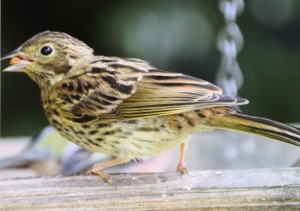 One of the interesting aspects of the group of birds known as “ buntings” is the way that some of them have adapted to the changing countryside. There are seven species, excluding the very rare ones, in the UK including two that do not breed namely the Lapland bunting and the Ortolan bunting. The snow bunting is very rare as a breeding bird with only around 50 pairs each year and all in the Highlands . Of the other four that do breed three are found in the Highlands but each of these have had problems in the last few years. The commonest of these is the yellowhammer although in the last decade it has been on the red data list which means it is among the most threatened birds in the UK. This can be because the number of birds is falling rapidly or that breeding ranges are contracting.
One of the interesting aspects of the group of birds known as “ buntings” is the way that some of them have adapted to the changing countryside. There are seven species, excluding the very rare ones, in the UK including two that do not breed namely the Lapland bunting and the Ortolan bunting. The snow bunting is very rare as a breeding bird with only around 50 pairs each year and all in the Highlands . Of the other four that do breed three are found in the Highlands but each of these have had problems in the last few years. The commonest of these is the yellowhammer although in the last decade it has been on the red data list which means it is among the most threatened birds in the UK. This can be because the number of birds is falling rapidly or that breeding ranges are contracting.
As is often the case with such birds the situation in the Highlands is better than further south perhaps because the changes in the countryside have not been quite so drastic. This is also reflected in the fact that the percentage of gardens in the Highlands occupied by yellowhammers is much higher than gardens in the rest of the UK. This increasing use of gardens has not only benefitted the yellowhammer but also the reed bunting that has also adapted to countryside changes. Yellowhammers are normally ground feeding birds and they were common on farmland because there was always spilled seed left on the ground from the various crops. Nowadays the lack of seed rich stubble fields and the loss of weeds have meant they have had to adapt. Most gardens where food is put out for a wide variety of birds rarely cater for such ground feeding birds so the birds have had to adapt even further. They will now readily come onto open topped bird tables for mixed seed. You can even get special trays that are close to the ground and yellowhammers will readily take to them. In my garden they freely come onto the top of an open topped bird table that measures three feet by two feet and sits on top of a pole. They will also go for the small trays under mixed seed feeders meant to catch any seed that are spilled by birds such as tits, siskins and chaffinches. I have yet to see yellowhammers tackle peanut holders or even the special feeders for sunflower seed or nyjer.
The reed bunting used to be a bird of farm hedges and scrub and as these declined the birds went to marshy areas and river banks. In the last few years small numbers have invaded gardens and have fed in much the same way as yellowhammers. However so far they do not normally come to gardens until the weather is poor such as frosts and snow. Another bunting that used to be locally common in the Highlands was the corn bunting. I can recall hearing their call notes, that really do sound like a bunch of keys rattling, in the fields around Tarbat Ness only several years ago. It seems that now the changes in agriculture have decimated the numbers and now apart from a small number breeding in the Western Isles the only breeding pairs in the Highlands are east of Inverness. There they are fed and agriculture methods modified to help them and the area now supports breeding corn buntings. Why the corn buntings have not managed to adapt to gardens in the same way as the yellowhammer and reed bunting is unclear
